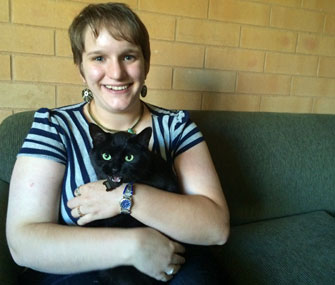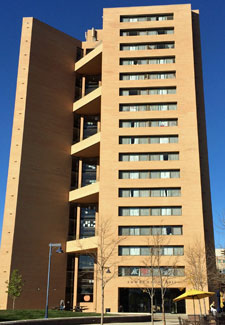Are Pet-Friendly Dorms Working?
Published on November 25, 2014

College students leaving the comfort and familiarity of home for the first time can experience a lonely and stressful transition, but a small number of schools across the nation are making this potentially difficult period easier by allowing students to bring their beloved pets to reside with them on campus. Schools such as MIT, Eckerd College, University of Washington and Stephens College have designated pet-friendly dorms where students can cohabitate with their furry family members.
Upon seeing the success of these programs, the University of Northern Colorado (UNC) in Greeley launched a pet-friendly housing program in the fall of 2014. For UNC, the stakes for success are high. Enrollment is down, the university has lost 1,000 students in the past five years, and the university is looking for new ways to attract and retain students. Jenni Brundage, assistant director of Apartment Life and Operations, expects the program to be a great recruitment and retention tool: There is already a waiting list, and the university may add additional floors next year.
How Pets Came to the University of Northern Colorado
Exactly why did UNC create the program? “We allow our live-in staff members to have pets, and a lot of students asked for pets themselves,” Brundage says. “We were getting an increasing number of applications for students to live with emotional support or therapy pets. There is a lot of off-campus housing that allows pets, and piloting this program opens the door for more students with pets to live on campus.” My practice, Sheep Draw Veterinary Hospital, serves as veterinary advisor for the program. In essence, we are the first line of care if the university has concerns about the care of the students’ pets. The hospital also provides education to students and staff about pet wellness and cares for many of the pets as patients. As a veterinarian, I was particularly curious about how this would work once the program began.

When Dr. Merideth Early, a colleague at Sheep Draw who is also president of the Weld County Veterinary Medical Association, sat on an advisory panel for the program at its inception, she says she was impressed with the level of care and responsibility demonstrated by the university. “The staff and students were interested in my input about making this a good experience for everybody. They really thought about everything, including not using the elevators so that students who have allergies won’t be affected by pet hair or dander in the elevator.” (Another way the school protects students with allergies: Laundry facilities have designated certain washers and dryers for the pet community. Everybody is free to use them, but the signs help pet-allergic students avoid contaminated machines.)
Putting the Program Into Action
The pet program encompasses the second and third floors of Lawrenson Hall, an imposing 16-story building in the middle of UNC’s campus. Students live in two-bedroom, apartment-style suites; there is a maximum of two animals per apartment. Each apartment has a sign outside the door with a picture of a dog or a cat and a number indicating how many of each pet is in the apartment. (This signage helps the UNC police department, facilities and maintenance staff know the type and number of critters to expect if they need to enter the premises.)
For now, the only pets in the program are cats and small dogs, none of whom weigh more than 40 pounds. The pets must stay in the apartments at all times, unless they’re coming or going from the dorm. It’s recommended — but not required— that pets be housebroken or litterbox trained. What’s more, all pets must be spayed or neutered, vaccinated against rabies, be registered in Weld County and be on a leash when out on campus. Finally, students are required to buy liability insurance, which costs about $15 a month.

A Tour of the Pet-Friendly Residences
To see how the program is progressing, we took a midsemester tour with Corey Friend, director of Lawrenson Hall. Friend is a pet lover himself and lives in the dorm with his dog, Kirby, a tiny, happy, fluff ball mix of Cavalier King Charles Spaniel and Bichon Frise.
Our first impression was that the pet-friendly hallways smelled clean — kind of like cranberries. Not one stray animal hair or piece of poo was spotted: Even the gated gravel outdoor dog run and elimination area was spotless. “Some of the other hall directors are jealous because they think the pet-friendly floors smell better than the pet-free ones,” Friend says about the cleanliness. “The students are very good about cleaning up after their dogs: They know that if there is a problem, they could be asked to leave the program. Our custodial staff cleans this area as well.”
What Students Are Saying
On the tour, we met Lawrenson resident senior Sarah Hammer and her rescue cat, Robin. Hammer is studying English with a minor in history, and her story is interesting in that it highlights the unconventional way this program is helping people succeed. She considers Robin a therapy cat. “Back in 2013 I was having a really hard time, so I got a cat, and she really helped me, made me feel like life was worth living again.”
Overall, the program is going very well, according to Hammer. “The only time I heard a bunch of dogs barking and freaking out was during the fire drill, which is understandable. I think there is more community because we have to work together to make it successful.”

Colorado native Morgan Monroe is another cat-loving participant in the program. She lived in Lawrenson last year. When she first went away to college, her parents cared for her 17-year-old feline, Bootsie, who experienced depression without Monroe and the cat had to go on medication. So when Monroe heard about the program, she signed up right away. “I am so happy to have Bootsie with me. I love him,” she says as she fusses over the furry senior citizen. “Everybody makes fun of me because I talk about my cat on a regular basis,” she says with a laugh. “He is like a family member. He is the unofficial mascot of my sorority, because on Tuesday nights we have dinner in the apartment and he hangs out with everyone.”
So Far, So Good
As far as dealing with issues with aggression or house-training, Brundage says, “We honestly haven’t had to cross that bridge yet, but the plan is to deal with issues on a case-by-case basis. The students are taking this privilege very seriously and are active advocates for this community.”
When asked how they ensure that the pets aren’t abandoned at the end of a semester or left unattended for an unreasonable amount of time in the dorms, she explains, “We do have an overnight policy: If a student is going to be absent overnight, we require a pet sitter, which could be a roommate, and we require that all pets are taken home for winter break. Most of the pets come from home and are family pets, so this hasn’t been an issue yet. Again, part of the purpose of this community is teaching students how to be responsible pet owners, and responsibility doesn’t stop with the end of the term.”
UNC will promote the groundbreaking program at the regional college housing conference in November. If the enthusiasm of the staff and student participants and those on the waiting list is any indication, this program will continue to grow in popularity, and we may see similar programs extend to other universities.





